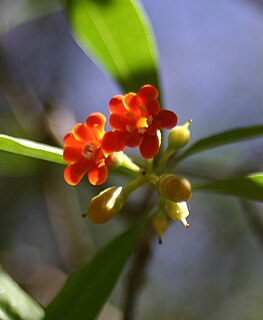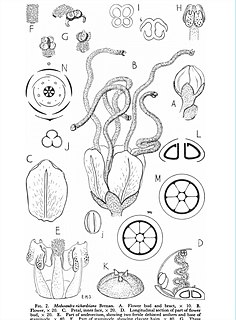Related Research Articles

The Alismatales (alismatids) are an order of flowering plants including about 4500 species. Plants assigned to this order are mostly tropical or aquatic. Some grow in fresh water, some in marine habitats.

The Dioscoreales are an order of monocotyledonous flowering plants in modern classification systems, such as the Angiosperm Phylogeny Group and the Angiosperm Phylogeny Web. Within the monocots Dioscoreales are grouped in the lilioid monocots where they are in a sister group relationship with the Pandanales. Of necessity the Dioscoreales contain the family Dioscoreaceae which includes the yam (Dioscorea) that is used as an important food source in many regions around the globe. Older systems tended to place all lilioid monocots with reticulate veined leaves in Dioscoreales. As currently circumscribed by phylogenetic analysis using combined morphology and molecular methods, Dioscreales contains many reticulate veined vines in Dioscoraceae, it also includes the myco-heterotrophic Burmanniaceae and the autotrophic Nartheciaceae. The order consists of three families, 22 genera and about 850 species.

The Malpighiales comprise one of the largest orders of flowering plants, containing about 36 families and more than 16,000 species, about 7.8% of the eudicots. The order is very diverse, containing plants as different as the willow, violet, poinsettia, manchineel, rafflesia and coca plant, and are hard to recognize except with molecular phylogenetic evidence. It is not part of any of the classification systems based only on plant morphology. Molecular clock calculations estimate the origin of stem group Malpighiales at around 100 million years ago (Mya) and the origin of crown group Malpighiales at about 90 Mya.

The Nymphaeales are an order of flowering plants, consisting of three families of aquatic plants, the Hydatellaceae, the Cabombaceae, and the Nymphaeaceae. It is one of the three orders of basal angiosperms, an early-diverging grade of flowering plants. At least 10 morphological characters unite the Nymphaeales. Molecular synapomorphies are also known.
Berberidopsidales is an order of Southern Hemisphere woody flowering plants. The name is newly accepted in the APG III system of plant taxonomy. APG II system, of 2003, mentions the possibility of recognizing the order, as comprising the families Berberidopsidaceae and Aextoxicaceae. However, APG II left the families unplaced as to order, assigning them to the clade core eudicots. The APG III system of 2009 formally recognized the order.

The Angiosperm Phylogeny Group (APG) is an informal international group of systematic botanists who collaborate to establish a consensus on the taxonomy of flowering plants (angiosperms) that reflects new knowledge about plant relationships discovered through phylogenetic studies.

Asphodelaceae is a family of flowering plants in the order Asparagales. Such a family has been recognized by most taxonomists, but the circumscription has varied widely. In its current circumscription in the APG IV system, it includes about 40 genera and 900 known species. The type genus is Asphodelus.

Gelsemiaceae is a family of flowering plants, belonging to the order Gentianales. The family contains only three genera: Gelsemium, Mostuea and Pteleocarpa. Gelsemium has three species, one native to Southeast Asia and southern China and two native to Central America, Mexico, and the southeastern United States. The eight species of Mostuea are native to tropical areas of South America, Africa, and Madagascar. The two genera were formerly classified in the family Loganiaceae. Pteleocarpa was originally placed in Boraginaceae or in its own family Pteleocarpaceae, but it is most closely related to Gelsemiaceae with which it shares significant characters.

Siparunaceae is a family of flowering plants in the magnoliid order Laurales. It consists of two genera of woody plants, with essential oils: Glossocalyx in West Africa and Siparuna in the neotropics. Glossocalyx is monospecific and Siparuna has about 74 known species.

Peridiscaceae is a family of flowering plants in the order Saxifragales. Four genera comprise this family: Medusandra, Soyauxia, Peridiscus, and Whittonia., with a total of 12 known species. It has a disjunct distribution, with Peridiscus occurring in Venezuela and northern Brazil, Whittonia in Guyana, Medusandra in Cameroon, and Soyauxia in tropical West Africa. Whittonia is possibly extinct, being known from only one specimen collected below Kaieteur Falls in Guyana. In 2006, archeologists attempted to rediscover it, however, it proved unsuccessful.

Theophrastoideae is a small subfamily of flowering plants in the family Primulaceae. It was formerly recognized as a separate family Theophrastaceae. As previously circumscribed, the family consisted of eight genera and 95 species of trees or shrubs, native to tropical regions of the Americas.

Tofieldiaceae is a family of flowering plants in the monocot order Alismatales. The family is divided into four genera, which together comprise 28 known species. They are small, herbaceous plants, mostly of arctic and subarctic regions, but a few extend further south, and one genus is endemic to northern South America and Florida. Tofieldia pusilla is sometimes grown as an ornamental.

Huerteales is the botanical name for an order of flowering plants. It is one of the 17 orders that make up the large eudicot group known as the rosids in the APG III system of plant classification. Within the rosids, it is one of the orders in Malvidae, a group formerly known as eurosids II and now known informally as the malvids. This is true whether Malvidae is circumscribed broadly to include eight orders as in APG III, or more narrowly to include only four orders. Huerteales consists of four small families, Petenaeaceae, Gerrardinaceae, Tapisciaceae, and Dipentodontaceae.

Medusandra is a genus of flowering plants in the family Peridiscaceae. It has two species, Medusandra richardsiana and Medusandra mpomiana. M. richardsiana is the most common and well known. Both species are native to Cameroon and adjacent countries.
Thomandersia is the sole genus in the Thomandersiaceae, an African family of flowering plants. Thomandersia is a genus of shrubs and small trees, with six species native to Central and West Africa.
The Angiosperm Phylogeny Website is a well-known website dedicated to research on angiosperm phylogeny and taxonomy.

Lepidobotryaceae is a flowering plant family in the order Celastrales. It contains only two genera, each with a single species: Lepidobotrys staudtii and Ruptiliocarpon caracolito.
Hondurodendron is a monotypic genus of tree endemic to Honduras. The only species in the genus, H. urceolatum, was discovered during 2004 and 2006 botanical surveys of plants in Parque Nacional El Cusuco in northwest Honduras. It was subsequently described in 2010 by Carmen Ulloa Ulloa, Daniel L. Nickrent, Caroline Whitefoord, and Daniel L. Kelly in the Annals of the Missouri Botanical Garden.
Limeum is a genus of flowering plants.
The Lophiocarpaceae are a family of flowering plants comprising mostly succulent subshrubs and herbaceous species native to tropical to southern sub-Saharan Africa to western India. It includes the genera Corbichonia and Lophiocarpus. The family is newly recognized through research by the Angiosperm Phylogeny Group III system to deal with long-standing phylogenetic difficulties in placing various genera within the Caryophyllales.
References
- ↑ Commended by, e.g., NCBI and Kew Archived 2009-02-14 at the Wayback Machine .
- ↑ "Stevens, Peter Francis (1944–)". Author Details. International Plant Names Index . Retrieved March 9, 2012.
- ↑ "Peter F. Stevens". Universität Hamburg. Archived from the original on July 30, 2003. Retrieved March 9, 2012.
- ↑ R. J. F. Henderson (1982). "Romnalda grallata, a new species of the Xanthorrhoeaceae from Queensland". Kew Bulletin . 37 (2): 229–235. JSTOR 4109965.